
Growing up in Beijing, soup was one of the must-have dishes on our dinner table everyday, even in the summer. It might be as simple as an Egg Drop Soup, or as luxurious as a Slow Simmered Oxtail Soup. It is a dish that connects all the elements on the table, like a glass of wine to a French family dinner. No matter if I’m traveling or living in a foreign country, I’d feel extreme comfort with a sip of hot soup, because it immediately brings me back home.
Vegetarian Hot and Sour Soup is one of those dishes that shows the simplicity and beauty of authentic Chinese cooking. Yes, the recipe might look quite long compared to my 5-Ingredient Chicken, but if you look through the ingredient list, you’ll find out that the recipe mostly uses dry products and pantry staples. In other words, this is a dish you can make even when your fridge is empty.
Yet the taste of the dish is nothing frugal. The silky soup bursts with a deep savory flavor that’s so appetizing and warms your whole body in a second. The veggies and tofu make give the dish substance which even allows it to be served as a main.
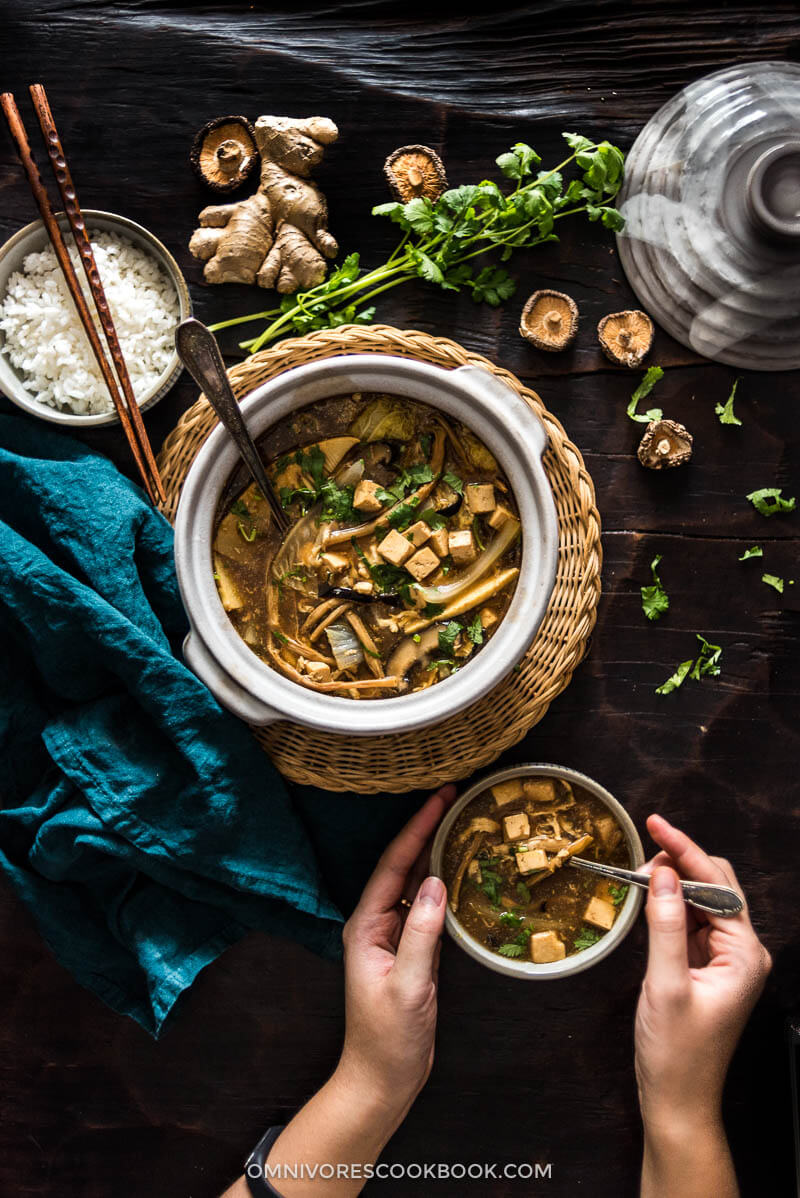
Where does that hot and sour flavor come from?
The answer is Chinkiang vinegar and white pepper powder.
Just to clarify, these are the standard ingredients for northern Chinese-style hot and sour soup. The Cantonese version does use other ingredients such as rice vinegar and chili oil.
Chinkiang vinegar (Zhenjiang vinegar, 镇江香醋) is a type of Chinese black vinegar. It is made with glutinous rice and wheat bran, and is aged until the color turns dark brown or inky black. It has a fermented malty taste and woody character that distinguishes it from the light colored and fruity rice vinegar.
Consider this ingredient the balsamic vinegar of Chinese cuisine, as it has a rich, pungent, and tart flavor, sometimes with a hint of sweetness.
There is no replacement for this ingredient, so go get a bottle now if you haven’t already. It is indeed a staple in any Chinese pantry and you’ll be addicted once you try it.
When combined with a spoonful of white pepper, you’ll be surprised how these two simple ingredients create such a potent, spicy taste with an earthy citrus zing.
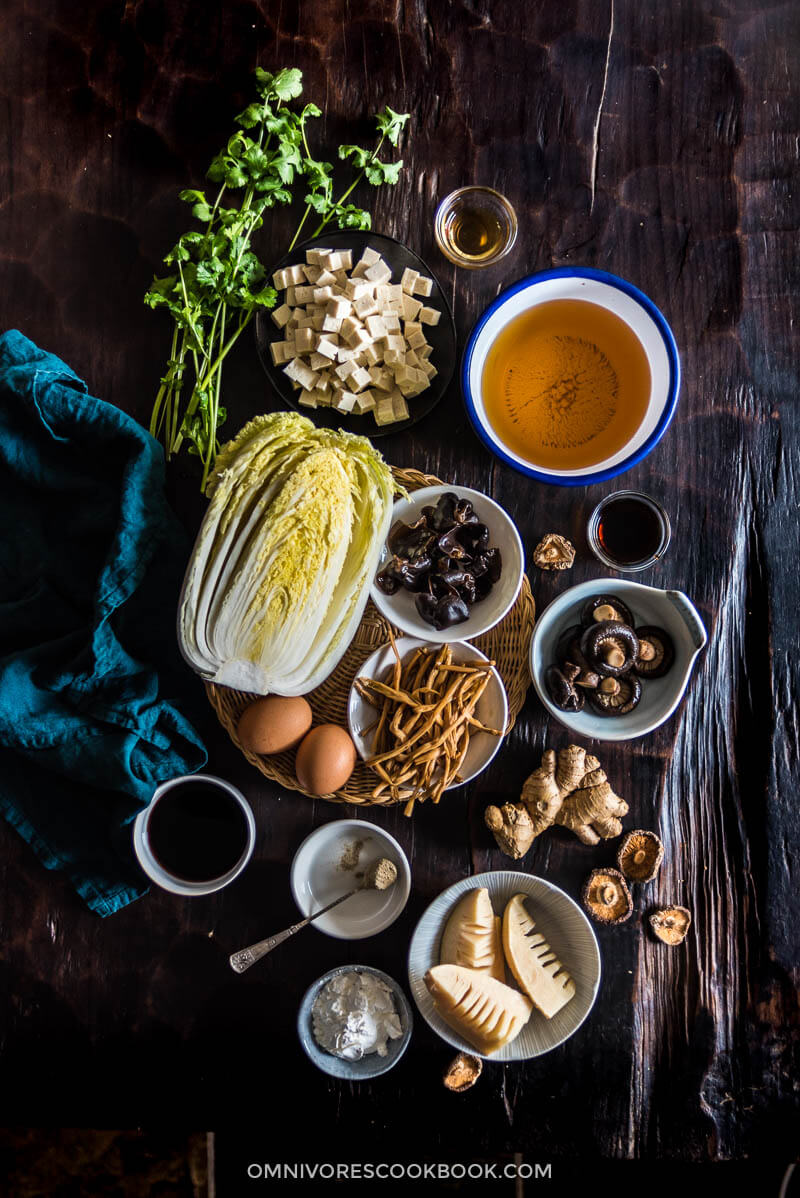
Why use dried ingredients?
Dried lily flowers and dried shiitake mushrooms are the most common ingredients we use in daily cooking. This is because they last a long time in the pantry, are cheaper in cost, and they add amazing flavors and textures in a dish.
When rehydrating dried lily flowers and dried shiitake mushrooms, the re-hydrating liquid becomes a perfect vegetable broth. The marinating liquid might have a earthy or even muddy smell, but once cooked, this taste will disappear in favor of a rich savory aroma.
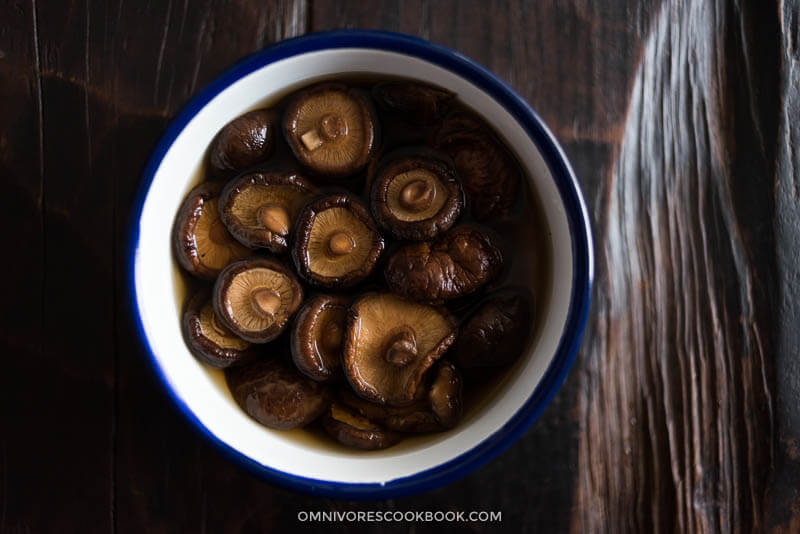
Unlike in French cooking, where chefs use expensive chicken or beef stock to make a soup, the Chinese soups that we serve daily are mostly made with water. That’s why the marinating liquid is so valuable, as it reduces the cost of a dish to a minimum.
If you rehydrate enough dried lily flowers and shiitake mushrooms, you can simply use the marinating liquid without needing extra vegetable stock.
On the other hand, if you do not have these dry goods on hands, you can skip them and use vegetable stock instead.
How to assemble your vegetarian hot and sour soup
1. How to create the soup base
Do not let the long recipe below scare you away. Vegetarian Hot and Sour Soup is a highly versatile dish that requires only 4 core ingredients:
- Chinkiang vinegar (2 tablespoons)
- White pepper powder (1 teaspoon)
- Stock (6 cups)
- Cornstarch slurry (3 tablespoons cornstarch + 1/4 cup water)
You see, you can use these ingredients to make the base of the soup and add whatever veggies you have on hand.
2. How to reduce prepping time
Like I mentioned above, if you do not have the dried goods (shiitake mushrooms and lily flowers), or do not have time to soak them, simply skip them and use vegetable stock instead.
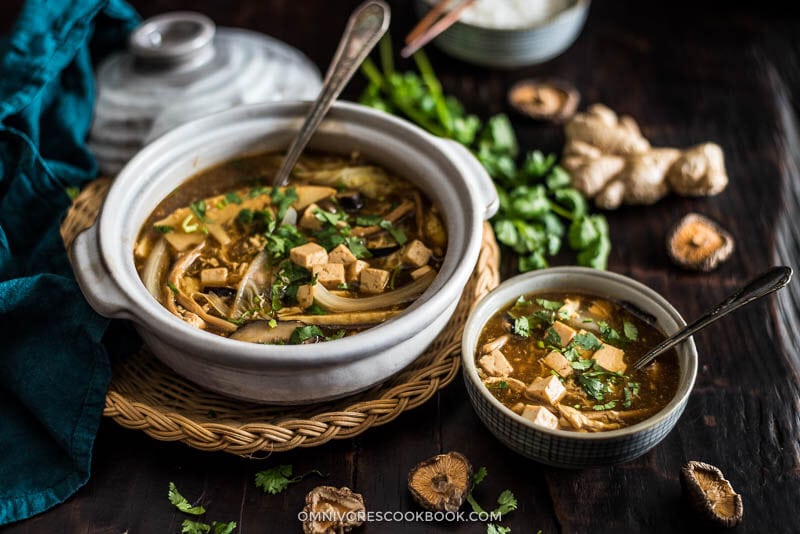
3. What ingredients to use
Once you’ve nailed the soup base, you can tweak the recipe with many other ingredients. My favorite way of assembling a soup is by using:
1 protein (1 cup) + 1 to 2 ingredients to add texture (2 cups) + 1 to 2 fresh vegetables to add more nutrients (2 cups) + beaten eggs (optional)
For the protein, either tofu or other tofu products (such as deep fried tofu) are a great choice. You can use them to add volume to the soup and turn it into a more substantial dish.
To add texture to the soup and make it more interesting, I love choosing from bamboo shoots, baby corn, rehydrated wood ear mushrooms, and water chestnuts. These ingredients may be dried or from a can.
For the vegetables, the options are limitless — some delicious ingredients include Napa cabbage, spinach, kale, collard greens, green peas, and baby bok choy.
Lastly, I always add beaten egg to make the soup more scrumptious. You can skip this to make the dish vegan.
To make it easier to browse, here is a summary chart. Simply choose the vegetables you prefer to assemble your own vegetarian hot and sour soup!
[one_third padding=”0 0 0 5px”]
Protein
- Fresh tofu
- Deep fried tofu
- Other soy products
[/one_third]
[one_third padding=”0 0 0 5px”]
Ingredients to add texture
- Bamboo shoots
- Baby corn
- Rehydrated wood ear mushrooms
- Water chestnuts
- Carrots (fresh or frozen)
- Corn (fresh or frozen)
[/one_third]
[one_third_last padding=”0 0 0 5px”]
Fresh ingredients
- Napa cabbage
- Spinach
- Kale
- Collard greens
- Green peas
- Baby bok choy
- Broccoli
- Bean sprouts
[/one_third_last]
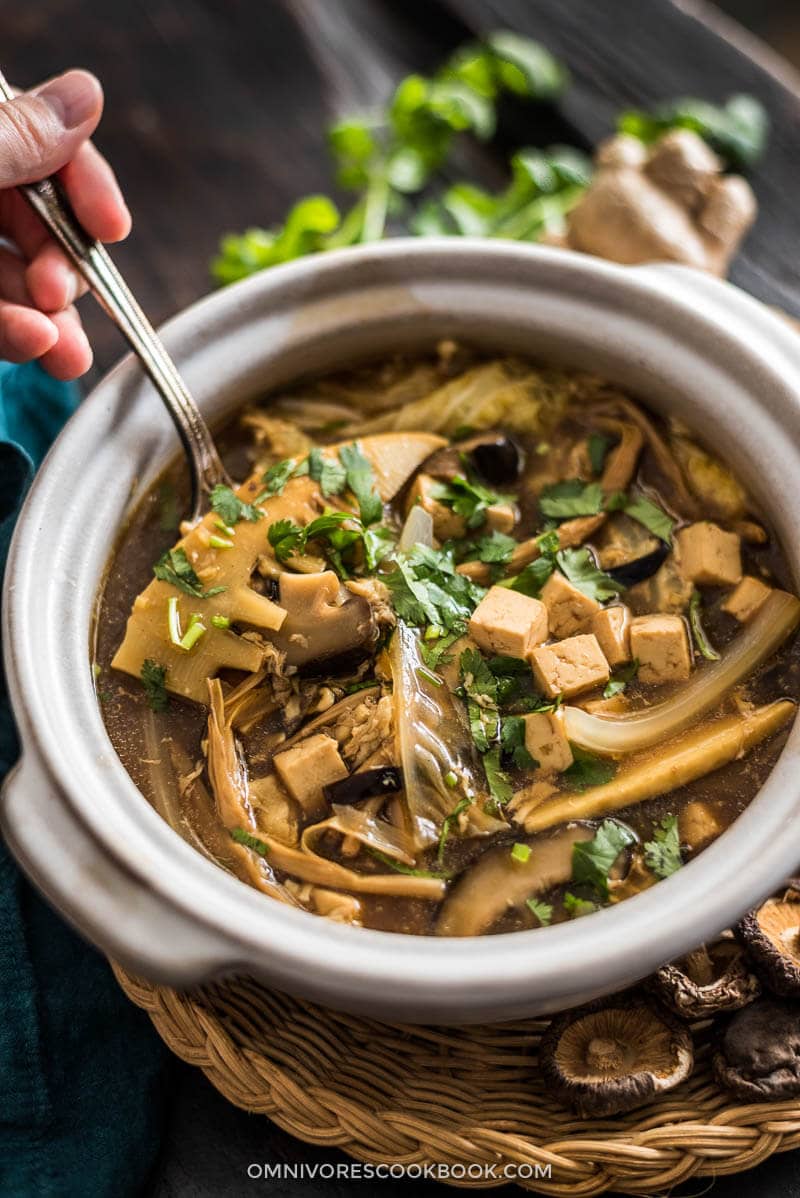
Are you ready to assemble your own Vegetarian Hot and Sour Soup? Hope you enjoy, and happy cooking!
If you give this recipe a try, let us know! Leave a comment, rate it (once you’ve tried it), take a picture and tag it @omnivorescookbook on Instagram! I’d love to see what you come up with.
Chinese Cooking Made Easy
Are you new to this website? This free email series is a great place to start. I’ll walk you through a few of my most popular recipes and show you how and why they work. You’ll quickly start to cook better Chinese food in your own kitchen.

Vegetarian Hot and Sour Soup (素酸辣汤)
Ingredients
Rehydrate
- 5 to 8 (about 1 tablespoon) dried wood ear mushrooms (*Footnote 2) (Optional)
- 1/3 cup shiitake mushrooms , dried
- 1 cup dried lily flowers , dried
Soup
- 2 tablespoons Chinkiang vinegar
- 1 teaspoon white pepper powder
- 6 cups vegetable stock (*Footnote 2)
- 1/2 block (8 oz / 226 g) firm tofu , cut to 1-cm (1/2-inch) cubes
- 1 can (5 oz / 141 g) bamboo shoots (about 1 cup)
- 1 tablespoon ginger , minced
- 1 tablespoon light soy sauce (or soy sauce)
- 1/2 tablespoon dark soy sauce (or soy sauce) (*Footnote 3)
- 1/2 teaspoon salt
- 2 cups Napa cabbage , chopped
- 3 tablespoons cornstarch
- 1 egg , beaten (*Footnote 4) (Optional)
- 2 teaspoons sesame oil , toasted
- 1/2 cup cilantro , chopped
Instructions
Rehydrate
- To rehydrate wood ear mushrooms, shiitake mushrooms and lily flowers, gently rinse each with tap water, drain and add to a bowl, then add hot water to cover at least 1-inch deep. Rehydrate for 30 minutes to 1 hour, until the ingredients have turned tender.
- For wood ear mushrooms, remove tough ends if needed, and slice into stripes.
- For shiitake mushrooms, reserve marinating water, gently squeeze water from the mushrooms, remove stems and thinly slice.
- For lily flowers, reserve marinating water. Remove the tough ends of the lily flowers and slice to 5mm (2-inch) pieces if needed (*Footnote 5).
Soup
- Add Chinkiang vinegar and white pepper into a small bowl, mix well until the white pepper is completely dissolved.
- Prepare a medium-size pot, add 1 cup marinating water from the shiitake mushrooms, 1 cup marinating water from the lily flowers, and 4 cups vegetable stock into a pot. Cook over medium-high heat. Add rehydrated wood ear mushrooms, rehydrated lily flowers, rehydrated shiitake mushrooms, tofu, bamboo shoots, ginger, light soy sauce, dark soy sauce, and salt to the pot. When the soup starts to simmer, add Napa cabbage and turn to medium-low heat. Cook until the Napa cabbage turns tender, 5 to 8 minutes.
- Whisk the cornstarch with 1/4 cup of water in a small bowl until cornstarch is fully dissolved. Slowly swirl the cornstarch slurry into the soup, and stir to thicken.
- Slowly swirl in the beaten egg with a fork against the edge of the bowl, and gently stir a few times to break up the eggs.
- Remove the pot from stove. Add the vinegar and pepper mixture and stir to mix well. (*Footnote 6) Carefully taste the soup. Add more salt if necessary. Garnish with cilantro and drizzle with sesame oil. Stir to mix well.
- Serve hot as a side or as a light main.
Notes
- Dried wood ear mushrooms will expand more than 10 times in size after soaking, so a small amount goes a long way. They do not have so much flavor and are added here to build texture. You can skip this ingredient without affecting the taste of the soup.
- The vegetable stock includes the marinating water from the shiitake mushrooms and lily flowers. In reality you will only need 3 to 4 cups extra vegetable stock. If you do not use shiitake mushrooms or lily flowers, you will need 6 cups vegetable stock.
- The dark soy sauce will add a beautiful dark brown color to the soup. You can use light soy sauce or ordinary soy sauce as a substitute.
- Skip the eggs if you are making a vegan soup.
- Depending on how the lily flowers are harvested, they might have a very tough woody end on the side of the stem. You can feel it by pressing with your fingers. You need to remove it (either by using a knife or a pair of kitchen shears). Some lily flowers might be very long, so you can halve them across.
- It is very important to add the vinegar and white pepper at the end, because both ingredients lose their aroma if cooked for too long.

Did you make this recipe?
I’d love to hear how it turned out for you! Please take a moment to leave a 5-star rating ⭐️ and share your thoughts in the comments further down the page. It really helps others discover the recipe too.
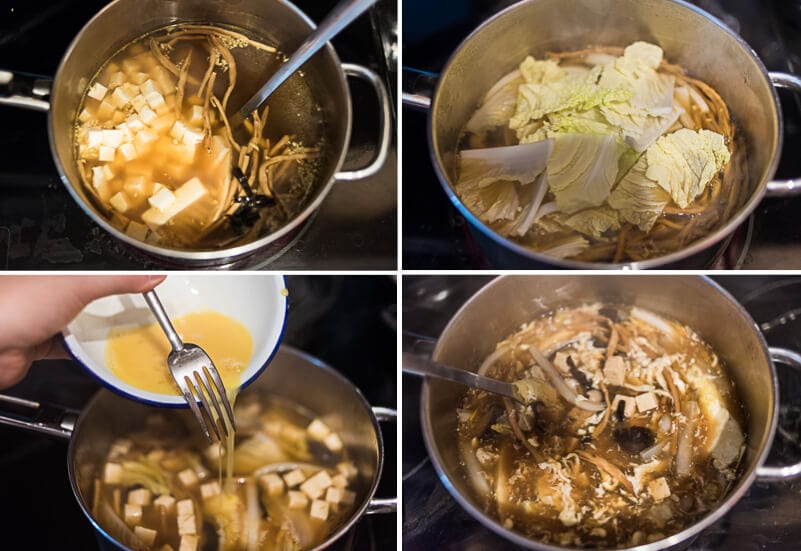

MKW
My husband adores Hot & Sour Soup and this recipe was a winner; he now asks me to make it once/week for him. We live in a rural area with no decent Chinese restaurants and the “Asian” style restaurants are extremely expensive & geared towards week-end tourists. So this recipe and in fact, your entire blog, has allowed us to enjoy terrific Chinese meals at home. Thank you!
Jon Zaid
What an amazing collection of recipes! I’m vegan and even the non-vegan recipes are adaptable. I made this one; exchanging collard greens for cabbage; cooking a little bit longer. Before putting in cornstarch, I threw in some Pancit noodles and let them cook for another 5 minutes. Then added cornstarch, and finally vinegar. Came out fantastic.
BTW, is there anyway to include photos?
Maggie Zhu
Thanks so much for leaving a positive review! The collard greens sound super tasty in the soup and I’ll try that out next time 🙂 Unfortunately there’s no way to include photos in the comment area. Please feel free to tag @omnivorescookbook if you share it on Instagram, so share the photos via email (info in my contact page).
Gina
What a great recipe! Couldn’t get dried lily flowers so I upped the amount of veg stock as indicated. Everyone in my family loved it and even my daughter wolfed it down although she doesn’t like spicy (the pepper comes out pretty strongly but I guess that’s the plan 🙂 ).
Valentino Azzurro
Excellent. Authentic – reproduces flavours of good restaurant soup. Sizes up or down, works with fish, pork, beef or prawns too. Got me eating tofu which I’ve always hated.
Oliver
Yesterday I made the soup according to the recipe, and it had an extremely strong and therefore somewhat unpleasant taste of dried shiitake and dried lily flowers. As I’ve never tasted the soup when I was in China, I don’t know if this is intended. I used 700ml of the rehydration liquid and 700ml vegetable stock. Is this too much of the rehydration liquid, i.e. should I use less of it next time, or is the soup supposed to taste like this? (In my home town there are no restaurants where I can try authentic hot and sour soup, unfortunately.)
Maggie
Hi Oliver, I think the taste of the dried ingredients might be unpleasant if they are too old (sometimes they are not fresh at the grocery store depending on where you get them so they taste kinda dusty). Shiitake mushrooms rehydration water can be quite strong, so you can definitely use less. The lily flower rehydration water has a special taste (very earthy) but it shouldn’t be unpleasant. We use a lot of rehydration water because we usually use water instead of stock to make the base. Next time if you are using a veggie stock, you should reduce (or skip) the rehydration water because veggie stock should add enough flavor.
Donna
Hello Maggie, I plan to make this today and know it makes 4 servings, but what is the serving size? I have all the ingredients but is there anything I can substitute for the soy sauces as even the lite has an extreme amount of sodium , as does fish sauce. If I could get around the high salt, I would be a happy camper!
Maggie
The recipe uses 6 cups liquid. On top of the veggies, you will have a pretty big pot of soup that contains at least 2 cups per serving.
For the soy sauce, maybe try a low-sodium one and use smaller amount (start with 1 teaspoon and add a bit more if needed). The soup is pretty sour so I’m afraid it won’t taste right if you do not add enough salt to balance it out…
Lakshmi
Hello maggie! I tried the recipe – for a big group of friends! (No trials here- as I’ve tried a couple of your other recipes and they have all been amazingly easy and nice!) And it turned out brilliant!! Yes the prep did take a wee bit of time, but once I got it on, it was very quick. I never thought I’d make hot and sour soup… Thank you.
Adina
Hi Maggie! I LOVE your blog! Tonight I tried making this Hot and Sour soup but the white pepper was overwhelming! The soup looks fantastic but it tastes SO peppery! I put in only 1 teaspoon with the 2 tablespoons of vinegar and I actually used 8 cups of water/Veg stock. Is there a way I can balance the white pepper taste? Will the peppery taste subside the next day when I’m enjoying the soup? Just want to see if you have an answer for this. Thank you so much for your time and for the beautiful site!
Katie
Hot and sour soup is such a comfort food item for me, and also what I named my blog! I love that it is so easily adaptable to be vegan-friendly. I did not know that vinegar and pepper should be added at the end, but that’s a great tip to add. I definitely have to make some tonight!
Maggie
How interesting! I’m glad to hear that you love the soup so much and named your blog after it 🙂
Joyce
This is my favorite Chinese soup. I grew up in Xi’An and I remember my mom used to make this during the cold seasons, especially when somebody in the family got a cold. I can have this soup for every meal.
Bam’s Kitchen
Feeling pretty happy as I have access to Chinkiang vinegar right here at the local market. Loving your vegetarian version! Where did you get your beautiful bamboo shoots? With the change of weather and this dampness needs we need this soup to stay healthy . Take Care
Maggie
I’m glad to hear that you managed to locate a good Asian market Bobbi! Chinkiang vinegar is truly unique and I cannot think of any replacement for it.
I got these bamboo shoots in our Japanese market. They are super pricy but worth it!
I hope your website issue will be solved soon. Stay warm and happy cooking 🙂
Wei @ Red House Spice
I like your version. Very authentic yet you provide a formula to make it flexible!! Great way to write recipes. I’ve been writing in a similar way. It’s reader-friendly.
Maggie
Thank you Wei! Yes I’d always prefer a formula because I like to change things up according to my pantry. Glad to hear you like this style too 🙂
Aimee Mars
This looks so delicious and I bet it’s the perfect weekday lunch. I find it so fascinating to learn about cuisines from other cultures and how interesting that each area has a different version.
Sarah | Well and Full
I haven’t had a good hot and sour soup in years…. and I’ve been intimidated to make it at home! But this recipe seems approachable so I definitely feel inspired!!
Maggie
Hi Sarah, the hot and sour soup is actually very easy to make if you have the right ingredients! Happy cooking and hopefully you’d like to challenge it in your own kitchen some day 🙂
Kevin | Keviniscooking
I make mine almost exactly Maggie! Really, but I add dried red chilies in the soup base, too. Once a guest was so surprised I actually had the dried lily buds in the soup. So good!
Maggie
The dried red chillies sounds so delicious! I’d like to try it out for my soup the next time. I believe you nailed the dish, since the lily buds IS the way to go 😉